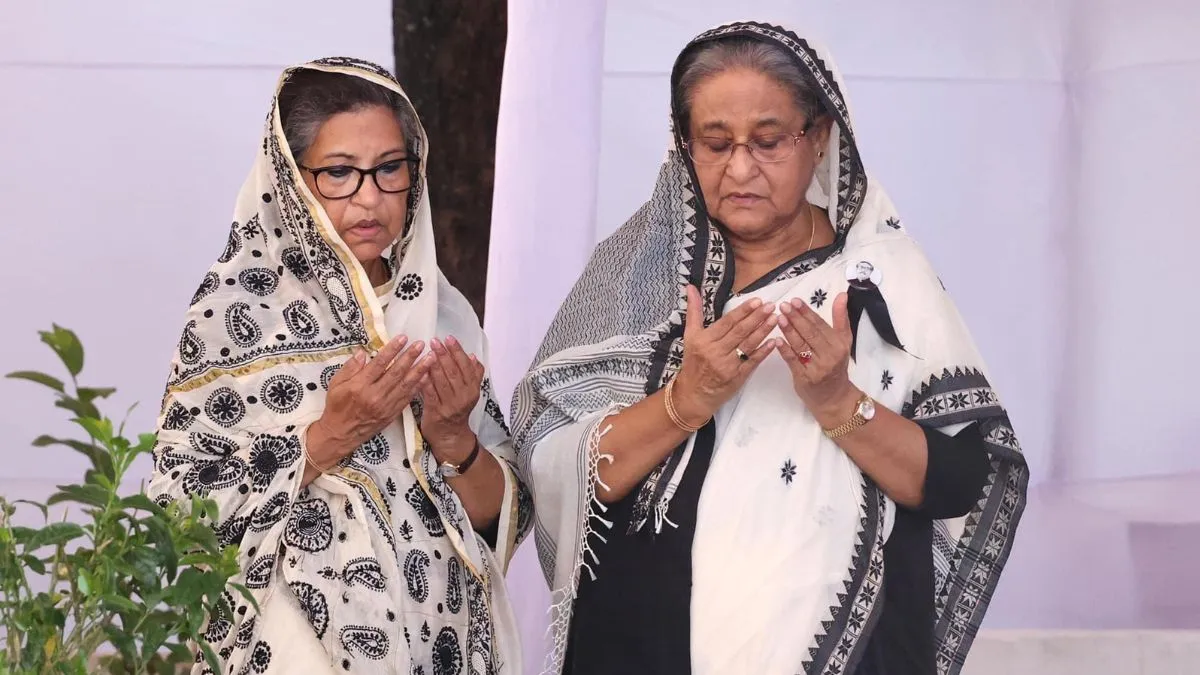- By Shivangi Sharma
- Mon, 17 Nov 2025 05:38 PM (IST)
- Source:JND
Sheikh Hasina’s life is a story shaped by tragedy, resilience, political ascendancy, and eventual downfall. Nearly five decades after she survived the brutal assassination of her family during the 1975 coup, Bangladesh’s longest-serving prime minister now faces a death sentence, an extraordinary reversal for a leader once considered the nation’s most dominant political force.
On 15 August 1975, Bangladesh was shaken by one of the darkest chapters in its history. In a pre-dawn coup, soldiers stormed the residence of President Sheikh Mujibur Rahman, the nation’s founding father. Except for Sheikh Hasina, her sister Sheikh Rehana, and her husband and children, the entire family was massacred. Mujibur Rahman, Hasina’s mother, three brothers, including the 10-year-old Sheikh Russell, and two sisters-in-law were killed. Hasina and Rehana survived only because they were in Europe at the time.

Sheikh Hasina with her sister, Sheikh Rehana Siddiq. (Image credits: Awami League/X)
In the aftermath, the two sisters sought refuge in the home of the Bangladeshi ambassador to West Germany before India’s Prime Minister Indira Gandhi granted them political asylum. Hasina lived in exile in New Delhi for six years, barred from returning by Ziaur Rahman’s military regime.
Education, Early Politics And Return From Exile
Before her life was upended, Hasina’s path was that of a politically active student. She attended schools in Tungipara and Dhaka, studied at Azimpur Girls’ School, Eden College, and later completed a degree in Bengali literature at Dhaka University in 1973. While in Rokeya Hall, she became involved in student politics through the Bangladesh Chhatra League, eventually becoming general secretary of its women’s unit. She married M.A. Wazed Miah, a respected nuclear scientist, in 1967.
In 1981, while still in exile, Hasina was elected President of the Awami League, the centre-left political party founded by her father. On 17 May 1981, she returned to Bangladesh to a massive public reception, marking the beginning of her political resurgence.
Years Of Struggle Under Military Rule
The 1980s were tumultuous. Under martial law, Hasina was repeatedly detained, under house arrest in 1984 and again in 1985 for extended periods. Yet she persisted, becoming the central opposition voice against military rule and later against the BNP government.

The political landscape shifted sharply in 1994 after a controversial by-election in Magura-2. Widespread allegations of rigging galvanised Hasina and the opposition to demand a neutral caretaker government for future elections. When the BNP refused, the Awami League and other parties launched a wave of nationwide shutdowns. By late 1995, AL and other MPs resigned en masse, triggering a political crisis. The February 1996 elections, boycotted by all major parties except the BNP, were dismissed by Hasina as a “farce.”
The Fall After Decades of Power
Hasina ultimately rose to become Bangladesh’s most powerful and longest-serving leader, shaping the nation’s economy, foreign policy, and political institutions. But in 2024, after mass protests, her government collapsed. Fleeing to India by helicopter, the 78-year-old leader watched her political legacy unravel.
In 2025, the International Crimes Tribunal sentenced Hasina to death, holding her responsible for violence against student protesters during the July movement. The verdict marked a stunning reversal in the journey of a woman who once embodied Bangladesh’s democratic aspirations.
ALSO READ: Bangladesh On Edge As ICT Pronounces Verdict Against Sheikh Hasina: Inside Five-Count Charge Sheet

-1763380640192_v.webp)